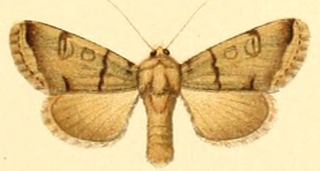Yigoga is a genus of moths of the family Noctuidae, it was placed as a synonym of Dichagyris by Lafontain & Fibiger in 2003.
Dichagyris is a genus of moths of the family Noctuidae. The former genera Loxagrotis, Pseudorichia, Pseudorthosia and Mesembragrotis are now considered subgenera of Dichagyris. From Greek dikha-gyris 'apart, asunder; double' + 'the finest meal or flour'; English pronunciation: /digh-kuh-JIGH-riss/, IPA [dɑj•kə'dʒɑj•ɹɪs].
Loxagrotis was a genus of moths of the Noctuidae family, it is now considered a subgenus of Dichagyris.
Mesembragrotis was a genus of moths of the family Noctuidae, it is now considered a subgenus of Dichagyris.
Proragrotis was a genus of moths of the Noctuidae family, it is now considered a synonym of Dichagyris.
Pseudoseptis was a genus of moths that belongs to the Noctuidae family, it is now considered a synonym of Dichagyris.
Stenosomides was a genus of moths of the family Noctuidae; it is now considered a subgenus of Dichagyris.

Dichagyris musiva is a moth of the family Noctuidae. It is found in some mountainous areas of Europe, Turkey, Armenia, the Caucasus, Anatolia, southern Siberia, Mongolia, Tibet and western China.
Basistriga was a genus of moths of the family Noctuidae, it is now considered a synonym of Albocosta, a subgenus of Dichagyris.
Dichagyris herculea is a moth of the family Noctuidae. It is found in Afghanistan, Pakistan, India, Tibet and Nepal.

Dichagyris candelisequa is a moth of the family Noctuidae. It is found from central Europe and southern Siberia to northern Iran, Afghanistan, Turkey and northern Africa.
Dichagyris melanura is a moth of the family Noctuidae. It is found from south-eastern Europe to Turkey, the Caucasus region, north Iran, Israel, Syria and Jordan.

Dichagyris singularis is a moth of the family Noctuidae. It is found from Turkmenistan to south-eastern Turkey, parts of the Middle East, Jordan, Israel, Iran and Afghanistan.

Dichagyris flavina is a moth of the family Noctuidae. It is found in most of the Balkans and through large parts of the Near East and Middle East. It has been recorded from Bulgaria, Romania, North Macedonia, Greece, Turkey, southern Russia, Armenia, Syria, Lebanon, Israel, Jordan, Iran and Iraq.

Dichagyris celsicola is a moth of the family Noctuidae. It is found in Greece, France, Italy and Turkey. It might also be present in Iran and Iraq.

Dichagyris forcipula is a moth of the family Noctuidae. It is found from central and southern Europe and Algeria, east to the Caucasus, Turkey, Syria, Lebanon, Iraq and Iran.

Dichagyris orientis is a moth of the family Noctuidae. It is found from Croatia, south to Macedonia, east to Romania, Ukraine and Russia and further east to central Asia, Turkestan, south-western Siberia, the Caucasus, Armenia, Turkey, Iran, western China and Mongolia.

Dichagyris multicuspis is a moth of the family Noctuidae. It is found southern Urals, Armenia, central Asia, Turkestan, the Tien-Shan Mountains, Korla, Turkey, Afghanistan, western China and Mongolia.

Dichagyris renigera is a moth of the family Noctuidae. It is found in South- and Southeast-Europe, Armenia, Caucasus and Turkey.
Dichagyris neoclivis is a species of cutworm or dart moth in the family Noctuidae. It was described by William Barnes and Foster Hendrickson Benjamin in 1924 and is found in North America.










